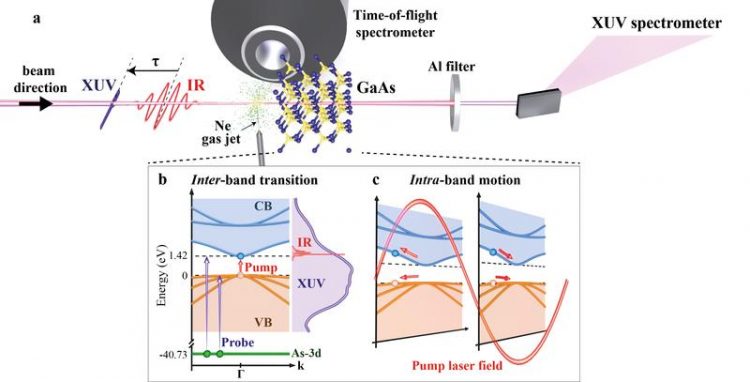Milestone study of excitation of electrons in GaAs at the attosecond level

(A) An intense few-cycle infrared (IR) laser pulse is combined with a single attosecond probe pulse with a spectrum in the extreme-ultraviolet (XUV) energy regime. Adapted from Schlaepfer et al., Nature Physics doi:10.1038/s41567-018-0069-0 (2018)
Fabian Schlaepfer and his colleagues in the experimental group of Ursula Keller at the ETH Institute for Quantum Electronics, together with Angel Rubio and Shunsuke Sato from the MPSD’s Theory department, combined transient absorption spectroscopy with sophisticated first-principles calculations to study and understand these processes. Their work has now appeared online in Nature Physics.
Gallium arsenide is a technologically important narrow-band-gap semiconductor, in which the excitation of electrons from the valence into the conduction band produces charge carriers that can transport electrical current through electronics components.
In addition to this so-called inter-band transition, carriers can also be accelerated within the individual bands as the electrons interact with the laser light. This intra-band motion is caused by the strong electric field associated with the laser light.
Which of the two mechanisms dominates the response to a short intense laser pulse, and how their interplay effects the carrier injection into the conduction band, is far from obvious.
The researchers found that intra-band motion does play an important role, as it significantly enhances the number of electrons that get excited into the conduction band. This finding was unexpected because intra-band motion alone is unable to produce charge carriers in the conduction band.
Their work has also now revealed that the nonlinear interplay between intra- and interband transitions opens a new excitation channel via virtually excited states at high pump intensities.
These results represent an important step forward in understanding the light-induced electron dynamics in a semiconductor on the attosecond timescale. The processes will be of practical relevance for future electronics and optoelectronics devices, whose dimensions become ever smaller and involve ever faster dynamics and ever stronger electric fields.
For further information please contact Jenny Witt, MPSD Press and PR
Tel.: +49 40 8998 6593
Email: jenny.witt@mpsd.mpg.de
Source publication: http://www.nature.com/articles/s41567-018-0069-0
Media Contact
More Information:
http://www.mpsd.mpg.deAll latest news from the category: Power and Electrical Engineering
This topic covers issues related to energy generation, conversion, transportation and consumption and how the industry is addressing the challenge of energy efficiency in general.
innovations-report provides in-depth and informative reports and articles on subjects ranging from wind energy, fuel cell technology, solar energy, geothermal energy, petroleum, gas, nuclear engineering, alternative energy and energy efficiency to fusion, hydrogen and superconductor technologies.
Newest articles

Machine learning algorithm reveals long-theorized glass phase in crystal
Scientists have found evidence of an elusive, glassy phase of matter that emerges when a crystal’s perfect internal pattern is disrupted. X-ray technology and machine learning converge to shed light…

Mapping plant functional diversity from space
HKU ecologists revolutionize ecosystem monitoring with novel field-satellite integration. An international team of researchers, led by Professor Jin WU from the School of Biological Sciences at The University of Hong…

Inverters with constant full load capability
…enable an increase in the performance of electric drives. Overheating components significantly limit the performance of drivetrains in electric vehicles. Inverters in particular are subject to a high thermal load,…





















